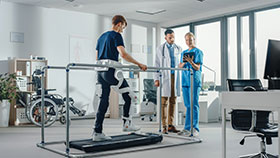 Master Bond produces a wide variety of polymeric adhesive systems which are capable of being utilized in the assembly of key parts/components for robots employed in the global healthcare industry. Compounds are application specific and are engineered to possess impressive mechanical, thermal, and electrical properties. Special formulations are noted for their ability to withstand many chemicals. Common compositions consist of epoxies, silicones, and UV light curable grades.
Master Bond produces a wide variety of polymeric adhesive systems which are capable of being utilized in the assembly of key parts/components for robots employed in the global healthcare industry. Compounds are application specific and are engineered to possess impressive mechanical, thermal, and electrical properties. Special formulations are noted for their ability to withstand many chemicals. Common compositions consist of epoxies, silicones, and UV light curable grades.
Examples of robotic parts/components that can depend in Master Bond for top performance include:
- Power supplies
- Controllers
- Motors
- Actuators
- Vision systems
- Grippers
- Navigation systems
- Display devices
- Wiring harnesses
- Sensors
- Gyroscopes
Many Master Bond adhesives can be incorporated in the following types of sensors for medical robots:
- Light
- Temperature
- Contact
- Proximity
- Sound
- Distance
- Tilt
- Positioning
- Acceleration
- Humidity
- Gas
Some examples of electronic circuit components that potentially rely on Master Bond for medical robots are:
- Resistors
- Capacitors
- Inductors
- Diodes
- Coils
- LEDs
- Semiconductors
- Switches
- Connectors
- Transformers
- Voltage regulators
- Photodiodes
Fixed, mobile, autonomous, remotely controlled medical robots in different sizes/shapes offer numerous possibilities for our compounds. The impact of medical robots is far reaching, diverse and plays an invaluable role in healthcare.
Types of Medical Robots
- Surgical robots/robot assisted surgery
- Food transport and support robots
- Radiotherapy robots
- Laboratory robots for repetitive tasks
- Rehabilitation robots
- Robotic prosthetics
- Robots for storage and distribution of medicine
- Robots for administrative and logistic tasks
- Robotic assisted biopsy
- Pharmaceutical robots
Medical robots can minimize human error and expedite medication delivery. They are frequently used to aid patients in hospitals, ambulatory surgery centers, rehabilitation centers, and external radiotherapy centers.

